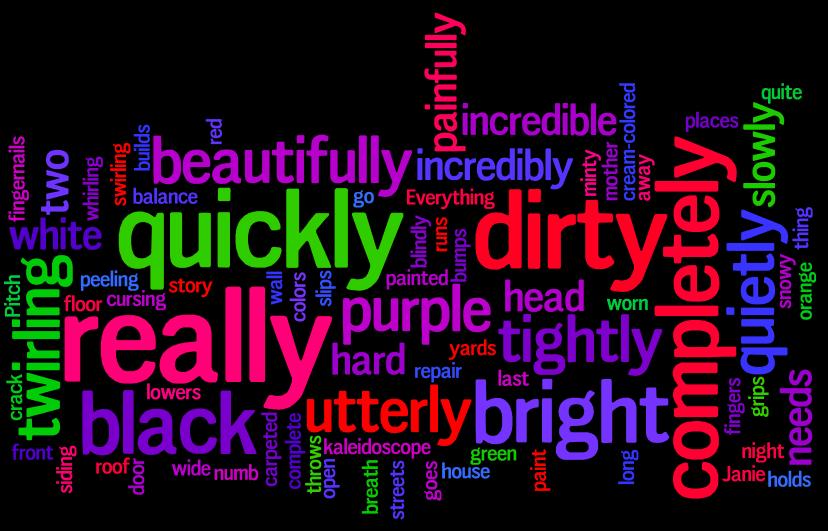
Janie runs quickly through the incredibly snowy yards from two streets away and slips very quietly through the bright purple front door of her two story house complete with cream-colored siding and a roof that needs to be repair.
And then.
Everything goes really black. Pitch black. As black as the night.
She holds her head tightly, cursing her mother under her minty breath as the whirling, twirling, swirling kaleidoscope of colors—red, orange, green, purple—builds quickly and throws her completely and utterly off balance. She bumps hard and painfully against the dirty white wall, the paint peeling in quite a few places and holds on really hard, and then very slowly lowers herself blindly to the worn carpeted floor as her fingers, with the beautifully painted long fingernails, go numb. The last thing she really needs is to crack her head wide open. Again.
Welcome to the not-so-wonderful world of overwriting. This is where the eager writer drowns his pose in adverbs and adjective, thinking it makes the writing more vivid. This is one of those times when the saying ‘less is more’ really does apply. As you can see from the above version of Lisa McMann’s novel, Fade (New York Times bestseller), all those adjectives and adverbs do nothing for the story. If anything, they bury Lisa’s compelling voice. Compare it to the actual version from the novel.
Janie sprints through the snowy yards from two streets away and slips quietly through the front door of her house.
And then.
Everything goes black.
She grips her head, cursing her mother under her breath as the whirling kaleidoscope of colors builds and throws her off balance. She bumps against the wall and holds on, and then slowly lowers herself blindly to the floor as her fingers go numb. The last thing she needs is to crack her head open. Again.
Do you see the difference?
In the first version, weak verbs are modified with adverbs. For example, ‘runs quickly, instead of ‘sprints’ and ‘holds her head tightly’ instead of ‘grips her head’. If you find you’re reaching for an adverb--especially one ending in –ly--to describe the verb, then grab your thesaurus and look up ‘run’. You’ll find an array of better words (bolt, sprint, dash, etc) that paint a concrete picture of what you’re character is doing.
For adjectives, don’t place a list of them in front of the noun. Try to keep it down to two. If you need to include more, than place some of them behind the noun. For example: Instead of “Tired, bruised, wearing a bloodied, torn dress, Alyssa stumbled along the road.” Write, “Tired and bruised, Alyssa, her dress bloodied and torn, stumbled along the road.” Also, delete any adjectives that are redundant. For example: a baby kitten is like saying a baby baby. All kittens are babies. Right?
Exercise: For your next writing project—fiction or non-fiction—highlight all the adjectives and adverbs, and see how many you can cut out and how many verb/adverb combinations you can replace with dynamic verbs. Your reader (and teacher) will thank you for it.
Recommended reading:
Sin and Syntax: How to Craft Wickedly Effective Prose, Constance Hale
Thanks, But This Isn’t For Us: A (Sort of) Compassionate Guide to Why Your Writing Is Being Rejected, Jessica Morrell
Note: This super cool picture was generated using the Wordle program at http://www.wordle.net/.